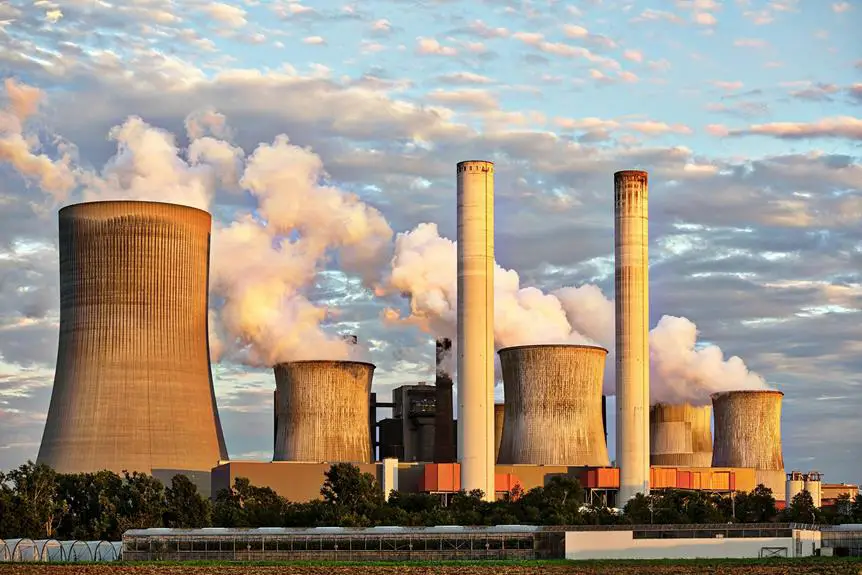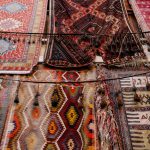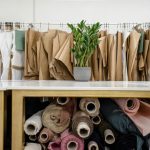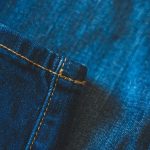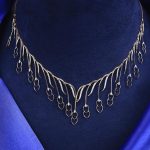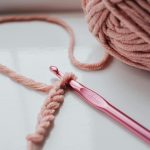When you consider the beauty of brocade, it's easy to overlook the hidden costs of its production. The process often demands an alarming amount of water and energy, not to mention the harmful chemicals used in dyeing. These factors not only strain local ecosystems but also contribute to broader environmental issues, like climate change. As you explore the implications of these practices, you might wonder what sustainable alternatives exist and how the industry can evolve to reduce its footprint. The answers could reshape your perspective on this luxurious fabric.
Table of Contents
Overview of Brocade Production
Brocade production involves weaving intricate patterns into luxurious fabrics, often using silk or synthetic fibers. You'll find that this process requires skilled artisans who expertly manipulate looms to create stunning designs. The artistry involved in brocade production is remarkable, as each thread contributes to a tapestry of color and texture.
Typically, the weaving process combines techniques that have been passed down through generations. You may notice that the patterns can range from floral motifs to geometric shapes, adding depth and richness to the finished product. The choice of materials plays a crucial role; silk provides a natural sheen, while synthetic fibers can offer durability and a wider color palette.
As you explore brocade fabrics, consider how the weaving process influences not just the aesthetic appeal but also the overall quality and longevity of the textile. This intricate craftsmanship often results in high-value items sought after in fashion and home decor.
However, it's essential to recognize the broader context of brocade production, including its environmental implications, which we'll delve into later. Understanding these factors can deepen your appreciation for the artistry behind each piece.
Silk Cultivation Practices
Silk cultivation practices involve carefully tending to silkworms, ensuring they thrive in optimal conditions for producing high-quality silk fibers.
You'll find that these practices require a deep understanding of the life cycle of the silkworm and its specific needs. By creating a controlled environment, you can enhance silk yield and quality significantly.
Key aspects of silk cultivation include:
- Temperature control: Maintaining a warm, consistent temperature helps the silkworms grow efficiently.
- Humidity management: Keeping humidity levels stable ensures the silkworms stay healthy and hydrated.
- Quality mulberry leaves: Feeding the silkworms fresh, pesticide-free mulberry leaves is crucial for producing strong silk.
- Cleanliness: Regularly cleaning the rearing space prevents diseases and promotes a healthy environment.
Chemical Use in Dyes
When dyeing fabrics, the choice of chemicals can significantly impact both the color quality and the environment. You might not realize it, but many traditional dyes contain harmful substances that can leach into waterways, affecting local ecosystems. Opting for eco-friendly alternatives not only benefits the planet but can also enhance the quality of your brocade.
Here's a quick comparison of common dye types and their environmental effects:
| Dye Type | Environmental Impact | Color Quality |
|---|---|---|
| Synthetic Dyes | High toxicity, water pollution | Bright, long-lasting colors |
| Natural Dyes | Biodegradable, lower toxicity | Earthy, muted tones |
| Low-Impact Dyes | Reduced chemical use, eco-friendly | Vibrant, less fade |
| Reactive Dyes | Moderate impact, requires water | Bold, rich hues |
| Direct Dyes | Can be non-toxic but varies | Good color yield |
Energy Consumption in Weaving
When you think about the weaving process, it's clear that energy consumption plays a significant role.
You'll discover how sustainable technologies and renewable energy integration can help reduce this impact.
Let's explore these aspects to understand their importance in brocade production.
Weaving Process Energy Use
The weaving process consumes significant energy, impacting both the environment and production costs. As you engage in weaving, you mightn't realize how much energy it takes to run the machinery, maintain temperatures, and ensure optimal conditions for fabric production. This energy consumption can lead to higher emissions of greenhouse gases, contributing to climate change.
Here are some critical aspects of energy use in the weaving process:
- Electricity Demand: Machines require substantial power, which can come from non-renewable sources.
- Heat Requirements: Maintaining the right temperature for fibers often necessitates additional energy.
- Operational Hours: Long production runs increase overall energy consumption.
- Maintenance Needs: Well-maintained machines operate more efficiently, reducing energy waste.
Sustainable Technologies in Weaving
Sustainable technologies in weaving aim to reduce energy consumption and minimize environmental impact, making production more efficient and eco-friendly. By integrating innovative practices and advanced machinery, you can significantly lower energy use during the weaving process. For example, modern looms are designed to operate with higher efficiency, using less power while maintaining optimal performance.
Implementing smart technology, like energy monitoring systems, allows you to track energy consumption in real-time, identifying areas for improvement. You can also optimize production schedules to run during off-peak hours, taking advantage of lower electricity rates and reducing strain on the grid.
Furthermore, using energy-efficient lighting and heating systems in your weaving facility can lead to substantial savings. LED lighting consumes far less energy than traditional bulbs and lasts much longer, while improved insulation can reduce heating costs during colder months.
Incorporating these sustainable technologies not only helps you cut down on energy bills but also enhances your brand's reputation. Consumers today are more environmentally conscious, and showcasing your commitment to sustainable practices can attract a loyal customer base, ensuring long-term success in the brocade market.
Renewable Energy Integration
Integrating renewable energy sources into your weaving operations can significantly reduce your overall energy consumption and lower your carbon footprint. By harnessing solar, wind, or hydroelectric power, you can create a more sustainable production process. This shift not only benefits the environment but can also improve your brand's reputation and appeal to eco-conscious consumers.
Here are some advantages of renewable energy integration in weaving:
- Cost savings: Over time, renewable energy can lower your electricity bills.
- Energy independence: Reducing reliance on fossil fuels protects your operations from volatile energy prices.
- Regulatory compliance: Many regions offer incentives for using renewable sources, helping you meet sustainability regulations.
- Enhanced innovation: Embracing new technologies can lead to improved efficiency in your manufacturing processes.
Water Usage and Pollution
When you consider brocade production, you can't ignore the significant water consumption rates involved.
The process not only uses vast amounts of water but also leads to chemical runoff that can harm local ecosystems.
It's crucial to understand how these factors contribute to water pollution and overall environmental impact.
Water Consumption Rates
Brocade production significantly strains water resources, both through excessive consumption and the pollution it generates. As you dive deeper into the brocade-making process, you'll notice that vast amounts of water are required for dyeing, weaving, and finishing. This high demand can lead to unsustainable practices that overdraw local water supplies, especially in areas already facing water stress.
Consider these critical points regarding water consumption rates:
- High Volume Usage: Producing just one kilogram of brocade can consume thousands of liters of water.
- Inefficient Processes: Many traditional methods lack modern efficiency, leading to more water waste.
- Regional Disparities: Water usage varies significantly across regions, affecting local communities differently.
- Diminished Resources: Over-extraction of water can lead to depleted aquifers and reduced water quality.
Chemical Runoff Effects
Chemical runoff from brocade production poses serious risks to both water quality and local ecosystems. When chemicals used in dyeing and finishing processes escape into nearby waterways, they can lead to significant pollution.
You mightn't realize that these toxic substances can harm aquatic life, disrupting habitats and causing long-term damage to biodiversity. Fish and other organisms often struggle to survive in contaminated waters, leading to reduced populations and even extinction of sensitive species.
Moreover, this runoff can impact drinking water sources, affecting communities that rely on these supplies. If you're living near brocade production facilities, you may unknowingly consume water tainted with harmful chemicals, raising health concerns for you and your family.
Additionally, chemical runoff can create dead zones in water bodies, areas where oxygen levels are too low for marine life to thrive. This phenomenon can disrupt local fishing industries and economies, further underscoring the interconnectedness of environmental health and human livelihoods.
Sustainable Alternatives and Solutions
Exploring sustainable alternatives can significantly reduce the environmental impact of fabric production, offering eco-friendly solutions that benefit both consumers and the planet. By choosing more sustainable materials and practices, you can contribute to a healthier environment while enjoying beautiful textiles.
Here are some options to consider:
- Organic Cotton: Grown without harmful pesticides, it reduces chemical runoff and supports biodiversity.
- Tencel (Lyocell): Made from sustainably sourced wood pulp, it uses a closed-loop process that minimizes waste and water usage.
- Recycled Fabrics: Utilizing post-consumer waste helps decrease landfill overflow and reduces the need for virgin materials.
- Hemp: A hardy plant that requires little water and no pesticides, hemp is a sustainable choice with a low environmental footprint.
Frequently Asked Questions
What Are the Historical Origins of Brocade Production?
Brocade production dates back to ancient civilizations, particularly in China and the Byzantine Empire. You'll find intricate weaving techniques developed over centuries, often linked to royal and ceremonial attire, showcasing opulence and artistic craftsmanship throughout history.
How Does Brocade Compare to Other Fabrics Environmentally?
When you compare brocade to other fabrics, you'll find that its production often requires more resources. While it offers beauty and durability, its environmental footprint can be heavier than simpler, natural alternatives like cotton or linen.
What Are the Economic Impacts of Brocade Production on Local Communities?
Brocade production boosts local economies by creating jobs and fostering craftsmanship. You'll see increased income for artisans, support for traditional techniques, and a rise in tourism, all contributing to community pride and economic resilience.
Are There Certifications for Sustainable Brocade Production?
Yes, there're certifications for sustainable brocade production. Look for organizations like GOTS or OEKO-TEX that ensure eco-friendly practices. These certifications help you support responsible producers while enjoying high-quality, beautifully crafted brocade products.
What Role Do Consumers Play in Promoting Sustainable Brocade Practices?
You play a crucial role in promoting sustainable brocade practices by choosing ethically produced fabrics, supporting brands that prioritize sustainability, and raising awareness about the importance of eco-friendly production methods in your community and social circles.
- How Does Ring Spun Cotton Affect Garment Fit and Shape Retention? - August 13, 2024
- What Are the Challenges in Producing Ring Spun Cotton? - August 13, 2024
- Is Ring Spun Cotton Suitable for Plus-Size Clothing? - August 13, 2024

